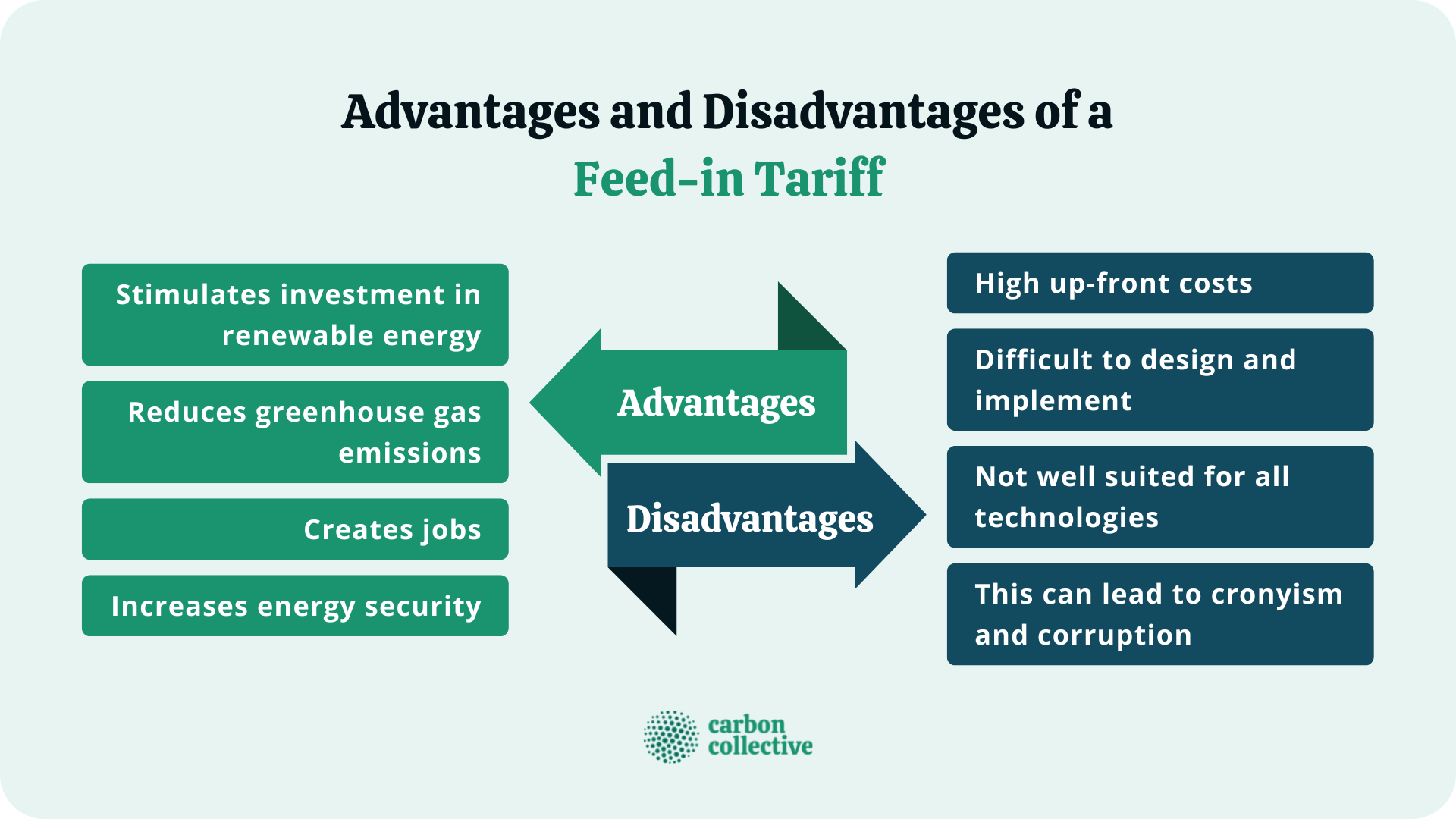Feed-in Tariff (FIT)
December 8, 2022
Author:
Zach Stein

What Is a Feed-in Tariff?
A feed-in tariff (FIT) is a policy mechanism that accelerates investment in renewable energy technologies.
A FIT provides a long-term contract between an energy generator and the utility company.
The terms of the contract define a set price that the utility will pay for energy generated by the renewable resource over some time, typically 20 years.
In some cases, the contract may also include an annual escalator to account for inflation.
How Does It Work?
A FIT allows renewable energy generators to sell electricity to the grid at a higher price than the prevailing market rate.
The higher price provides a financial incentive for investments in renewable energy, and over time as the technology becomes more widespread, the price paid for renewable energy will decrease.
How Does a FIT Compare to Other Incentives?
A variety of policies encouraging the development of new renewable capacities are more commonly used in the United States.
These include rebates for purchasing renewable generation equipment, renewable portfolio standards (RPS), net metering, and tax incentives (production- or investment-based).
The federal wind production tax credit is one example of the latter. Each of these policies has its strengths and weaknesses; it helps to consider them before implementation.
However, they provide a practical way to encourage the increased use of renewable energy sources.
How Can I Take Advantage of the Feed-in Tariff Program?
Generators can take advantage of the feed-in tariff program by signing a contract with their utility company. Utility companies must offer a FIT contract to any generator that meets the eligibility requirements.
Another way is to participate in a FIT program that a state or local government has established. This is done by installing renewable energy generation equipment and following the program guidelines.
Qualifying Technologies
The FIT in the United States generally includes solar photovoltaic technologies but may also have other renewable energy technologies such as geothermal or biomass.
In contrast, other countries' FITs, particularly the German and Danish programs where the policy was originally tested and developed, initially focused on supporting wind energy.
In U.S. states with a Renewable Portfolio Standard (RPS), the FIT-eligible technologies generally overlap or coincide with RPS-eligible technologies. For example, the FIT set by the Los Angeles Department of Water and Power applies to all technologies eligible for the California RPS.
Therefore, though there is some variation in eligible technologies from country to country and state to state, overall, the goal of FITs remains the same: to support the development of renewable energy sources and help reduce greenhouse gas emissions.
Advantages of a Feed-in Tariff
FIT has a fair share of advantages:
Stimulates Investment in Renewable Energy
Long-term contracts provide predictability and stability for investors, which is essential for investments with a high up-front cost.
Reduces Greenhouse Gas Emissions
FITs create an incentive for renewable energy generation, reducing power sector emissions.
Creates Jobs
The installation and maintenance of renewable energy generation equipment create jobs in the construction and manufacturing industries and the renewable energy sector.
Increases Energy Security
FITs help to diversify the energy mix and reduce dependence on imported fuels.
Disadvantages of a Feed-in Tariff
Below are some disadvantages of FIT:
High Up-Front Costs
FITs increase the cost of electricity for consumers in the short term as the higher prices paid for renewable energy are passed on to consumers.
Difficult to Design and Implement
FITs can be complex and challenging to design and implement. In particular, setting the right price for renewable energy can take time and effort.
Not Well-Suited for All Technologies
FITs may not be the best policy for promoting certain technologies, such as mature technologies with low costs or technologies that require little investment.
Can Lead To Cronyism and Corruption
FITs can create opportunities for corruption and cronyism if the selection of projects or technologies is not transparent.

The Bottom Line
A feed-in tariff (FIT) is a policy that requires utilities to purchase renewable energy from generators at a predetermined rate.
FITs can be an effective way to encourage investment in renewable energy and help reduce greenhouse gas emissions. However, they also have some disadvantages, such as the high up-front costs.
FITs are complex policy tools, and their success depends on their design and implementation.
FAQs
1. Is FIT the best policy for promoting renewable energy?
FITs are just one of many policy tools that can be used to promote renewable energy. Their effectiveness depends on their design and implementation.
2. What technologies are eligible for the FIT?
The technologies eligible for the FIT vary from country to country and state to state. Solar photovoltaic technologies are generally eligible, but other renewable energy technologies may also be included.
3. How does a FIT compare to other incentives?
FITs provide stability and predictability for investors, which is essential for investments with a high up-front cost. Other incentives, such as tax credits, may be more effective for mature technologies with low costs or technologies that require little investment.
4. What are the disadvantages of a FIT?
The disadvantages of a FIT include high up-front costs and difficulty setting the right price for renewable energy. In addition, FITs can create opportunities for corruption and cronyism if the selection of projects or technologies is not transparent.
5. How can I take advantage of the FIT program?
You can use the FIT program by installing eligible renewable energy technologies and selling the energy to your utility at a predetermined rate.
Our difference
01.
We're clear eyed.
We think financial security and climate health are directly linked.
02.
We're independent.
We're not owned by a big bank or Wall Street firm.
03.
We're real people.
You'll feel it the moment you meet us.

